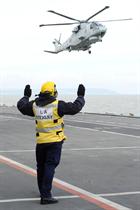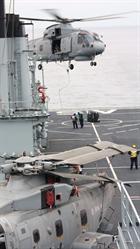Merlin Mk2s deploy en masse for first time
The Royal Navy’s new submarine-hunting helicopters will face their greatest test yet when they head into the Atlantic next week in the biggest exercise of its kind for many years.
Taking part in Exercise Deep Blue in the Western Approaches, the nine Merlin helicopters will join HMS Illustrious to practise skills which were once the mainstay of the Royal Navy’s aircraft carrier operations.
It’s the first time the latest version of the Merlin – the Mk2 – has been tested en masse. After more than a decade on the front line, the Merlin fleet – based at Royal Naval Air Station Culdrose in Cornwall – is in the midst of a £750m revamp which will help to keep them at the forefront of naval warfare until the end of the 2020s.
Two of Culdrose’s four Merlin Squadrons have already been converted to the improved helicopter – which looks the same outwardly, but inside is a completely new box of tricks – including the first front-line unit, 820 Naval Air Squadron.
The Merlin Force will spearhead Exercise Deep Blue, with nine new Mk2s due to join the Portsmouth-based carrier and a further Merlin embarked in HMS Westminster, a T23 frigate – the largest concentration of submarine-hunting helicopters in recent memory, and the largest ever concentration of Merlins at sea.
“Nine Merlins on one carrier is a sight no-one has seen – and which we will never forget. We’re looking forward to it big time – especially the younger men and women.” said Commander Ben Franklin, Commanding Officer of the Royal Navy’s Maritime Merlin Force.
“For us, Deep Blue is a high tempo and multi-aircraft exercise which will test the new version of the Merlin but ultimately help us to prepare for operations onboard the Royal Navy’s new aircraft carrier.”
In preparation for ‘Carrier Operations’, the main focus of Culdrose’s role once the Royal Navy’s new aircraft carrier is launched in July, the Air Station has formed a ‘Carrier Air Group’ (CAG) to bring different squadrons, engineers and aircraft together. Exercise Deep Blue will be the first time that the Culdrose Merlin ‘CAG’ will deploy.
Ben explains: “Operating from sea and conducting Anti Submarine Warfare is what we do, but this exercise presents an opportunity to deploy en-masse. We are using the exercise to practice multi-aircraft embarked operations and the engineering and logistical support necessary for this.”
The Merlin Force is expecting great things from Deep Blue following the success of the new Merlin on recent exercises Dynamic Mongoose and Joint Warrior. However, Deep Blue is on a far grander scale. For the Merlins to hunt submarines continuously around the clock – using either their dipping sonar, or passive sonobuoys (‘underwater ears’) – nine helicopters are needed, hence the size of the operation.
It will also demand the efforts of around 200 personnel, including 18 crews each comprising of one pilot, one observer and one aircrewman. After a week and a half’s training around the UK by day and night, HMS Illustrious and her helicopters will move out into the expanse of the Atlantic for Deep Blue itself, which reaches its climax in mid to late June.
Link to article about Merlins working during Ex Deep Blue.



